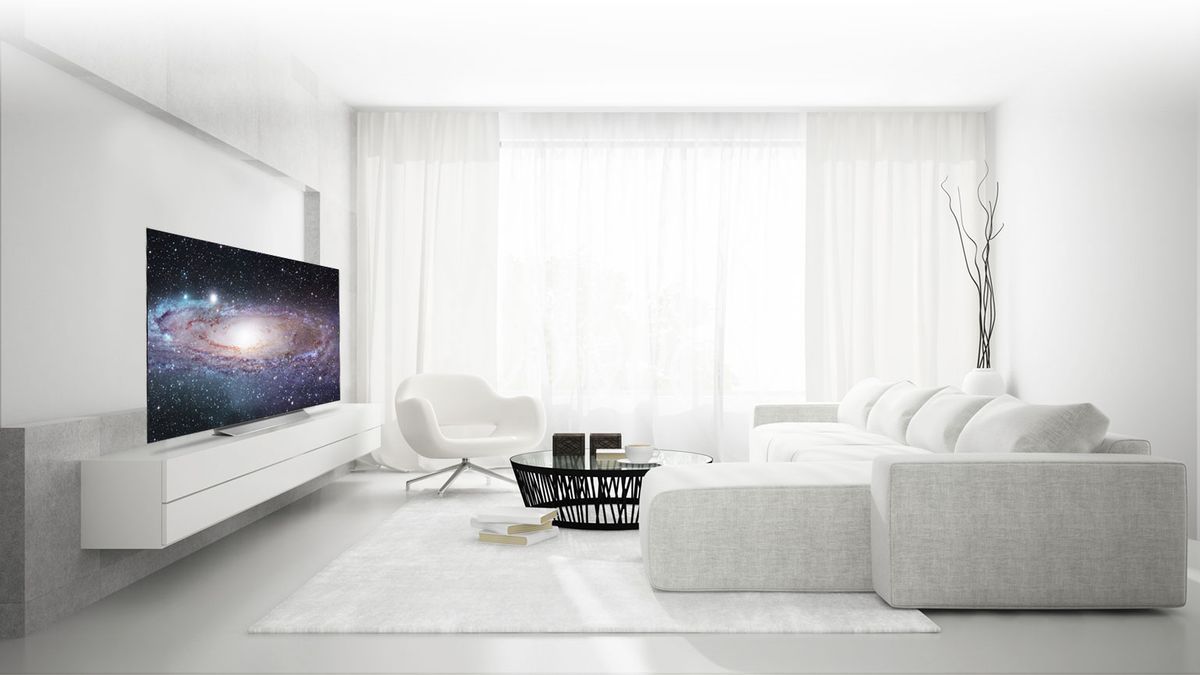TechRadar Verdict
The LG OLED C7 is a high dynamic range performer that doesn't sacrifice OLED’s class-leading standard dynamic range capabilities.
Pros
- +
Stunning contrast-rich pictures
- +
Gorgeous ultra-thin design
- +
Excellent operating system
- +
Good value for OLED
Cons
- -
Occasional noise issues
- -
Lacks brightness vs LCD
- -
Limited color volume
- -
More expensive than LCD
Why you can trust TechRadar
Over the past few years LG has led the way when it comes to 4K TVS, bringing us all some of the most affordable, best-looking OLEDs.
There are few better examples of this than the 2017 LG OLED C7 OLED - and specifically its 55-inch incarnation, the OLED55C7. Even after reviewing the flagship W7 OLED, the ultra-affordable-but-harder-to-find B7 OLED and newer models like the C8 OLED and B8 OLED, we still feel this TV presents an outstanding value for people looking to score OLED on the cheap.
While the newer models add a few features you won't find on 2017 sets - like larger Look Up Tables and newer processors - the C7 benefits from a lower price, often in the range of a few hundred dollars / quid. (Though, that hasn't quite turned out to be the case for Black Friday and Cyber Monday 2018...)
Regardless, the OLED C7 still offers a great balance between price and performance, providing a screen that delivers a great picture via self-illuminating pixels at a price that many more of us than ever before can afford.
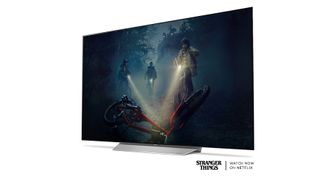
Design
Despite not using the unique ‘picture on glass’ technology sported by LG’s step up E7 and G7 OLED TVs, the OLED55C7 is still a staggering feat of design.
Gone are the days of the 2016 LG OLED C6’s curved screen and arrived are the 2017 C7’s gleaming, ultra-minimalist back veneer and millimeters-thin chassis. It’d be one of the slimmest screens in LG’s line-up if there wasn’t a chunkier section at the bottom of the rear side that accommodates the screen’s connections, drivers and speakers. Unfortunately, however, if you're after that paper-thin level of slimness you’ll still need to look to the W7 OLED.
But that’s not to say LG traded any form for function here: It has the narrowest of black frames around the screen’s edge, giving it a picture on wall appearance. It's a TV that looks every penny - and then some - of its $2,200/£2,500 price.
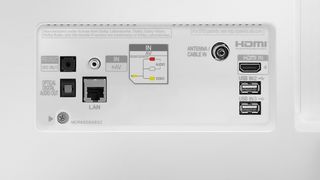
In terms of connectivity, four HDMI inputs (all of which, impressively, can handle full-bandwidth 4K HDR signals), three USBs and both Wi-Fi and Ethernet network options, make sure the C7 OLED is well-stocked in the IO department.
The only concern we have with the design is that the attractive, well-built metallic stand that comes with the OLED55C7 feels exceptionally heavy for something that’s attached to such a slender screen. Handle yours with extreme care and teach young children and large pets to steer well clear of it!
Design TL;DR: If there’s a more attractive, futuristic-looking TV out there, we haven’t seen it.
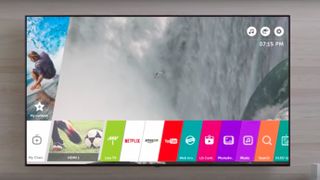
Smart TV (webOS 3.0, Freeview Play)
LG’s webOS smart TV interface was the first one that really felt like it had been developed from the ground up for TV rather than smartphone or PC users: It’s graphically rich, incredibly straightforward and logical in its layout, easily customizable, slick to navigate and sensibly focussed on the sort of TV-centric apps most users actually want a TV to deliver.
These apps include (4K/HDR-capable) versions of Amazon and Netflix, Youtube, NowTV, plus all of the catch up services for the main terrestrial UK broadcasters courtesy of the Freeview Play service, which lets you search for shows you might have missed via an electronic program guide that scrolls back through time as well as forwards.
The latest version of webOS built into the OLED55C7 only really delivers a couple of relatively minor enhancements over previous versions: support for ‘360’ VR clips navigated by waving LG’s magic remote control around; and the option to use the number buttons on the remote control to directly access favourite apps. But there’s no need to fix something that isn’t broken.
Smart TV TL;DR: Slick, logical, unfussy, uncluttered and easy to follow, webOS remains the most user-friendly smart TV system in town.
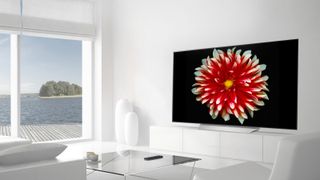
HD/SDR Performance
OLED has delivered the most all-round beautiful SDR pictures for a couple of generations now and, happily, this trend continues with the OLED55C7.
Its combination of essentially perfect black levels, immaculate backlight uniformity, immense amounts of shadow detail and wonderfully rich, beautifully consistent colors really does leave you feeling as if you’re witnessing SDR looking as good as it’s likely ever going to look.
It’s great to see, too, that LG has improved its high definition to 4K upscaling for this year’s models: The OLED55C7’s upconverted pictures look sharper and more detailed, and there’s less noise and forced edging. Colors retain their tonal integrity during the upscaling process better now, too.
LG still isn’t quite as assured with its HD upscaling as Samsung and, especially, Sony, but the gap has certainly been greatly reduced. So much so that many people will likely not consider it an issue worth worrying about when considered in the context of all the excellent other picture qualities the OLED55C7 delivers.
HD/SDR Performance TL;DR: Improved HD upscaling and exemplary SDR playback make the OLED55C7 a superb performer with aging HD content.
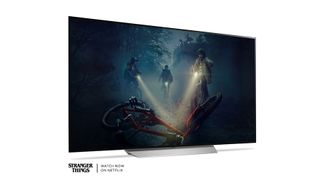
4K/HDR Performance
OLED technology, because of the way each pixel produces its own light and color independently of its neighbors, has long made OLED a natural friend of high dynamic range pictures.
Certainly the way the OLED55C7 can deliver its deepest black colours right alongside its brightest HDR whites and colours without either a hint of light pollution between the two or any dynamic brightness compromises gives it a huge advantage over even the best LCD TVs.
It’s great, too, to see the OLED55C7 offering much better control over the ‘near black’ parts of its pictures than any previous generation of OLED TV. No longer do just-above-black parts of the picture look noisy, blocky or unstable. There’s also no repeat of the strange ‘black blocking’ noise that occasionally cropped up in exceptionally dark HDR images with last year’s C6 model.
Last year’s OLED sets also sometimes saw their usually outstanding black level depths suddenly wash out into an uncomfortable grey if a high-contrast HDR shot contained just the wrong amount of brightness. This issue, too, has been sorted - with HDR10 sources, anyway - by LG’s new processing engine, further boosting the consistency of the OLED55C7’s HDR playback.
The surprising exception to this improved black level consistency is Dolby Vision.

When watching The Fate Of The Furious and Power Rangers 4K Blu-rays in Dolby Vision (which adds a layer of extra scene by scene information to the core HDR10 stream), some scenes containing a mix of bright and dark content caused the OLED55C7’s black levels to ‘blow out’ into greyness quite distractingly using the default picture settings.
This is a curious problem when you consider that Dolby Vision’s algorithms supposedly take into account the particular capabilities of the TV it’s working with, and is presumably a result of Dolby driving LG’s panel a bit harder than LG itself does with its HDR10 playback (certainly the Dolby Vision images look more dynamic, with more detail, colour finesse and brighter white ‘peaks’).
You can stop the Dolby Vision black level wash outs by reducing the TV’s brightness by five or six steps. However, doing this means images look markedly less ‘HDR’ than they do when using the native HDR brightness setting, so it’s a compromise that on balance we suspect many viewers won’t want to make.
Hopefully this may be something Dolby and LG are able to tweak via a firmware update at some point, because it’s important to stress than in every other way Dolby Vision Ultra HD Blu-ray pictures really do look nothing short of magnificent on the OLED55C7.
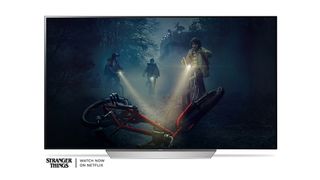
While better than last year, motion still looks a little more juddery with movies than it does with some rival sets - and LG’s motion processing still tends to throw up slightly more unwanted side effects than we’d like. It’s hard if not impossible to get an absolute perfect balance on the OLED55C7 between brightness and noise – the Standard picture preset makes HDR look far punchier and more satisfying than the Cinema presets, but can occasionally cause some low-level fizzing noise to appear in dark parts of the image that contain a lot of subtle detail. The Cinema modes remove this noise, but lack that lovely extra dynamism that I believe convincing HDR needs.
That's where the flaws end, though. The OLED55C7’s picture performance is ultimately and categorically defined by its strengths, not its flaws.
The most satisfying thing for us is that if you stick with the Standard picture preset, the extra 20% or so of extra brightness LG has managed to find for its 2017 TVs has a transformative effect on its HDR performance. Those traditional inky OLED blacks can now sit alongside markedly bolder whites, delivering a much greater sense of contrast, and greatly elevated average brightness levels for HDR content.
This latter effect makes exterior HDR scenes look more lifelike and, more importantly, more balanced. By which we mean that when dark objects in a picture appear against bright backdrops, they no longer look like empty silhouettes. This latter point is a big deal for us, as it makes HDR much more comfortable to watch.
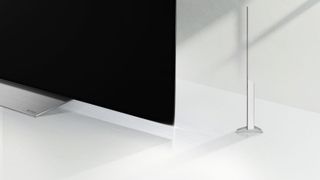
However, the ability of OLED to deliver pixel-level light and color precision means the OLED55C7’s images enjoy an intensity that LCD TVs, with their much less localized light controls, struggle to match, despite their extra brightness. It’s notable, too, that colors enjoy a gorgeous consistency right across the screen, rather than having their saturations reduced in places by the localized backlight clouding, striping and blocking that LCDs suffer from.
Finally, the OLED55C7 proves a treat for gamers thanks to taking just 21ms to render its pictures, and delivers more impact from good quality native 4K sources than any previous OLED generation. This latter strength is mostly down, it seems, to LG’s improved color subtlety and light controls in the image’s darkest and brightest areas.
It’s ultimately the sense of immersion created by its many picture strengths that makes the OLED55C7 so special. Aside from the very sporadic appearance of a little noise in dark areas when using the best Standard picture preset and a few sudden black level reductions with Dolby Vision sources, there’s really nothing in the OLED55C7’s pictures to distract you from what you’re watching by reminding you of the technology you’re watching them on.
4K/HDR Performance TL;DR: The extra brightness LG has found for its OLED TVs this year has a transformative effect on the OLED55C7’s stellar HDR and 4K picture quality.
Sound
In the sound department, the LG OLED C7 is a mixed bag of tricks. Literally.
For instance, despite not having any visible speakers, the OLED55C7 supports Dolby Atmos. This only works with Atmos carried by Dolby Digital containers, though, not the Dolby True HD containers used on Blu-rays and Ultra HD Blu-rays (which greatly limits its usefulness) but it’s still of value for the hardcore audio enthusiasts among us.
Problematically, though, while the support for the all-encompassing audio technology is there, it’s questionable whether you can ever get a truly Atmos effect from an integrated TV sound system. Certainly the OLED55C7’s sound system delivers no sense of sound coming from behind you or above you, as you would expect with a true/full Atmos system.
That’s not to say there's no Atmos-like effect here.
One way or another the screen delivers some startlingly accurate placement of front soundstage details. For instance, as the jets fly by the college in Arrival you can clearly follow their trajectory from top left up and out of the tip right, with the height ultimately extending to a position above the tip right corner. Voices, too, sounds unusually accurately positioned on the screen.
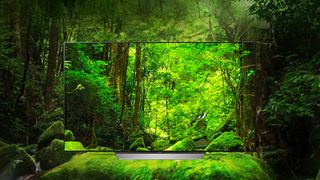
For music lovers, the C7 can get loud without distorting or sounding harsh, it rolls off bass early enough to stop it causing distortion but not so early that action scenes sound excessively thin and harsh. The amount of detail you can hear in the mix is prodigious, too. Almost hi-fi standard, in fact.
Despite its surprising strengths, the OLED55C7’s sound is no match for LG’s step-up OLED55E7 (we've reviewed the 65-inch E7) model with its built-in soundbar. Bass, while well managed, is limited in its range. Male voices can sound a little thick and muffled. And finally there’s no real sense of expansion in the soundstage when action scenes kick in.
Sound TL;DR: The OLED55C7 delivers surprisingly clean, punchy sound from seemingly nowhere. Its Dolby Atmos claims are a bit of a stretch, though.
Other panels to ponder
If you want the same stunning picture as the OLED55C7 coupled with a markedly more powerful sound system and an even prettier ‘picture on glass’ design, you could step up to LG’s £2,999/$2,999 OLED55E7 model.
Alternatively, if you can live with a slightly less attractive silvery frame around your picture and a less heavy duty, less opulent looking stand, you can currently save around £250 (close to $1,000 in the US) by buying an OLED55B7 instead.
If you’re tempted by LCD’s extra brightness, Sony’s impressive XBR-55X930E (called the KD-55XE9305 in the UK) is currently available online for less than $2,000/£2,000, while Samsung’s curved-screen QE55Q8C, with its high color volume QLED technology, costs around £2,500/$2,500.
Verdict
The OLED55C7 serves up pictures every bit as fantastic as those of LG’s more expensive 2017 OLED TVs - and is even remarkably close to the 2018 models - but at a much cheaper price.
Ultimately, if you can live without the ‘picture on glass’ designs and more powerful speakers of LG’s more recent and higher-end models, the OLED55C7 can be considered a massive bargain for such a talented set. Its B7 models are even cheaper, it must be said, but we think the OLED55C7’s superior design makes it the pick of LG’s last iteration of OLEDs from 2017.
- For our other top picks, check out our guides to the best TVs and best 4K TVs.
John has been writing about home entertainment technology for more than two decades - an especially impressive feat considering he still claims to only be 35 years old (yeah, right). In that time he’s reviewed hundreds if not thousands of TVs, projectors and speakers, and spent frankly far too long sitting by himself in a dark room.

CrowdStrike warns of fake job offer scam that is actually just malware

Fed up with Copilot in Windows 11? Microsoft pushing a new keyboard shortcut for the AI isn’t likely to help, and it could mess with your desktop mojo

Hisense’s L9Q laser TV is the best new projector I saw at CES 2025 and beats most OLED TVs
